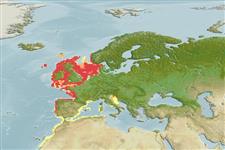Preferred temperature (Referencia
123201): 7.1 - 12.8, mean 9.6 °C (based on 168 cells).
Phylogenetic diversity index (Referencia
82804): PD
50 = 0.5625 [Uniqueness, from 0.5 = low to 2.0 = high].
Bayesian length-weight: a=0.00741 (0.00637 - 0.00863), b=3.10 (3.06 - 3.14), in cm total length, based on LWR estimates for this species (Ref.
93245).
Nivel trófico (Referencia
69278): 3.7 ±0.1 se; based on diet studies.
Resiliencia (Referencia
120179): Medio, población duplicada en un tiempo mínimo de 1.4-4.4 años (K=0.2-0.4; tm=1-2; tmax=4; Fec=200,000).
Prior r = 0.32, 95% CL = 0.21 - 0.48, Based on 1 data-limited stock assessment.
Fishing Vulnerability (Ref.
59153): Low to moderate vulnerability (26 of 100).
🛈
Climate Vulnerability (Ref.
125649): Low to moderate vulnerability (34 of 100).
🛈
Nutrients (Ref.
124155): Calcium = 69.1 [17.6, 230.8] mg/100g; Iron = 0.679 [0.148, 3.039] mg/100g; Protein = 18.8 [16.2, 20.9] %; Omega3 = 0.649 [0.318, 1.346] g/100g; Selenium = 14.4 [6.8, 30.3] μg/100g; VitaminA = 13.5 [3.5, 52.7] μg/100g; Zinc = 1.29 [0.32, 3.68] mg/100g (wet weight); based on
nutrient studies. 